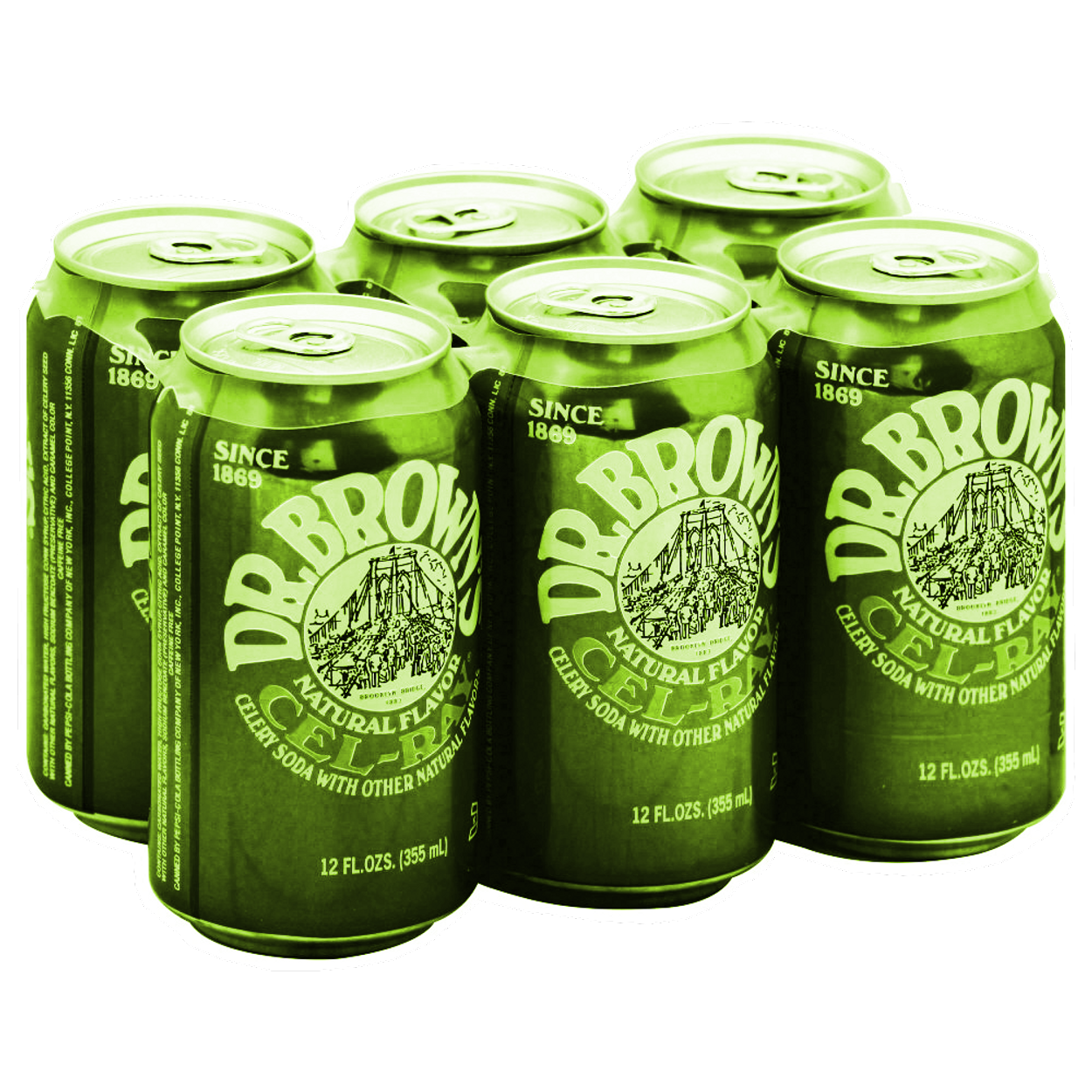An Acquired Taste
A toast to Cel-Ray, the one and only celery soda




For most people, there are two choices for pastrami sandwich accompaniment: cream soda or Cel-Ray. Cream soda, the prevalent option, is a retiring beverage. Too feeble for a lead, it plays decent second fiddle to a salty meat sandwich. Then there’s Cel-Ray, the connoisseur’s choice.
For newbies, Cel-Ray is a celery-flavored soda manufactured by Dr. Brown’s and available at every good Jewish delicatessen in New York. It can be difficult to locate outside the Empire State, but devotees order it by the case online and store it like bomb shelter supplies. Stroll past Katz’s or the Second Avenue Deli and you’ll spot a grass-green can or two, with its distinctive psychedelic font and Brooklyn Bridge doodle. An average of $2.50 per can is a hefty sum to pay for flavored bubbles, but Cel-Ray is not an everyday drink.
Its crisp, vegetal scent yields to a mellow caramel taste that won’t pickle your tongue with sweetness. “Jewish Champagne” is how Walter Winchell described it, and it’s as light and effervescent as that implies. If an admirer gave you a bouquet of fresh celery, the smell might remind you of Cel-Ray. One gulp cuts the fat of a juicy sandwich and cleanses the palate without tasting, as cream soda does, like dessert. Plus, it has insider caché: only serious eaters choose Cel-Ray. If you can persuade a kid to take a sip, you deserve an extra pickle.
Like any rarefied product, Cel-Ray has a thriving online community of fans. On BevNet, a site devoted to the beverage industry, a commenter says that Cel-Ray is a “soda for discriminating tastes”; another notes that “for over 40 years of my life I have delighted at the unique flavor and spice of dr browns celray. I must have it at every Jewish holiday. and anytime a pastrami sandwich is present.” When the odd dissenter pipes up (“I almost threw up it was so bad”), he or she is vigorously rebuked (“You don’t serve a ten dollar soda to a five cent customer”). Other voices tend toward the philosophical: “Maybe Dr. Brown’s Cel-Ray is like gefilte fish. If you haven’t grown up with it, it is totally off the wall.”
Jack Lebewohl, owner of the Second Avenue Deli, confirms the impression. “It’s a very unique taste,” he explains. “You either like it or you hate it. Myself, I like it very much. It’s a little sweet, with a bitter taste at the end.” And is it popular? “Around 12 to 15 percent of customers order celery soda,” he says. “Most people stick to cream soda, or sometimes cherry.” At Katz’s, executive chef and manager Kenny Kohn estimates that Cel-Ray makes up “two percent, three percent, no more than that” of the total beverage sales. “Most people who drink it are old-timers,” he tells me. “You don’t see teenagers or kids in their 20s getting a celery soda. But for the old deli crowd, it’s a tradition.” When I ask if he chooses to down Cel-Ray with his pastrami, Kohn laughs. “Do I drink it? Nah. Not my cup of tea…not my cup of celery!”
The soda’s origins are foggy. It’s not clear whether an actual Dr. Brown existed, but most accounts point to beginnings on the Lower East Side around 1870, when the drink was marketed as a health tonic. Dr. Brown’s has no official website, and may be the only brand of celery-flavored soda. It’s canned at a plant on Long Island called Pepsi-Cola of New York, though Dr. Brown’s is owned by Canada Dry.
To find out more, I call the bottling plant and reach Rosalie Mileo, the customer service manager for Dr. Brown’s. I ask her to tell me about the company. “There is no Dr. Brown’s,” she says. “It’s just a name.”
Whatever the ontology of the company, she does concede that Cel-Ray lags considerably in popularity behind the other Dr. Brown’s sodas, which include black cherry, cream soda, root beer, diet cream soda, and diet black cherry. A diet version of Cel-Ray was produced until several years ago, Mileo tells me, and Cel-Ray is most in demand in New York and in Florida, “because lots of retired New Yorkers live there,” she adds.
“Are there plans to stop manufacturing Cel-Ray any time soon?” I ask.
“There are no plans to stop manufacturing Cel-Ray any time soon,” she echoes.
“Can you tell me anything else about Cel-Ray?” I ask.
“It’s not popular,” she replies firmly. Perhaps the mere thought of celery soda perturbs her, as it does most people. This is something I cannot understand, given that root beer and ginger ale are also tasty sodas with unappetizing origins. And cream soda takes its flavor inspiration from—yuck—a dairy product. Not that this matters. A soda, after all, is not required to be conceptually sound, but merely delicious. Which Cel-Ray is.
Molly Young is a writer in New York.